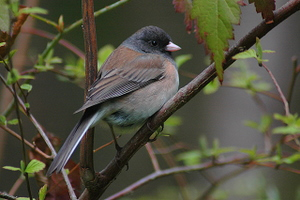The several recognizable groups or subspecies of dark-eyed juncos formerly were recognized as distinct species. Further genetic studies are likely to alter current views on the relationships of these groups and other junco species.
Photo Credit: Geoffrey A. Hammerson
Junco hyemalis
Common Name: dark-eyed junco
Animal Guild: Bird
Class > Order > Family: Aves > Passeriformes > Passerellidae
What does the species look like?
Plumage details vary considerably throughout the range, but the following is broadly applicable. Adults lack streaks and typically have dark eyes and a gray to black (sometimes tinged brown) "hood" over the head and breast, a white belly, and conspicuous white outer tail-feathers on an otherwise dark tail. Typically the bill is pinkish (or bluish, grayish, or bicolored). Males and females are similar but females in some subspecies average paler and browner than males. The appearance changes little throughout the year. Juveniles generally resemble the overall adult plumage pattern but are browner in color, often with a buffy undertone on the breast, and the adult pattern is largely obscured by coarse streaking on the head, back, and underparts. The eyes of juveniles are grayish, and some juveniles have pale wing-bars.
Where is the species found?
States & Provinces
AB, AK, AL, AR, AZ, BC, CA, CO, CT, DE, FL, GA, IA, ID, IL, IN, KS, KY, LA, MA, MB, MD, ME, MI, MN, MO, MS, MT, NB, NC, ND, NE, NH, NJ, NL, NM, NS, NT, NU, NV, NY, OH, OK, ON, OR, PA, PE, QC, RI, SC, SD, SK, TN, TX, UT, VA, VT, WA, WI, WV, WY, YT
Distribution
Breeding range extends from Alaska eastward across central Canada to Labrador and Newfoundland, south to northern Baja California, Arizona, western Texas, southern Saskatchewan, southern Manitoba, Great Lakes region, and southern New England, and in the Appalachian Mountains to northern Georgia. Winter range extends from southern Canada south through the United States to Florida, southern Texas, and northern Mexico.
Habitats include various sorts of coniferous, mixed, and deciduous forest; forest edge; forest clearings; bogs; open woodland; brushy areas adjacent to forest; and burned-over lands. In migration and winter the species occurs in a wide range of openly wooded and brushy and grassy habitats. Nests are in scrapes on the ground and usually are concealed by logs, rocks, tree roots, leaves, or ground vegetation.
General Phenology and Life History
South-bound migration from the northern breeding range occurs primarily September-November. Migration to northern breeding areas occurs mainly March-May. In most areas, nesting occurs from April to as late as August (median fledging date around late June), but earlier nesting may occur in southern lowland areas and fledging may sometimes extend into September. Clutch size usually is 3-5. Incubation lasts about 11-12 days. Both parents feed nestling and newly fledged young. Depending on local conditions, pairs raise 1-2 broods per season.
Which phenophases should I observe?
Do you see/hear...?
Activity
Live individuals More...
For abundance, enter the number of individual animals observed in this phenophase.
Feeding For abundance, enter the number of individual animals observed in this phenophase.
Fruit/seed consumption For abundance, enter the number of individual animals observed in this phenophase.
Insect consumption For abundance, enter the number of individual animals observed in this phenophase.
Calls or song For abundance, enter the number of individual animals observed in this phenophase.
Singing individuals For abundance, enter the number of individual animals observed in this phenophase.
Territorial individuals For abundance, enter the number of individual animals observed in this phenophase.
Reproduction
Courtship For abundance, enter the number of individual animals observed in this phenophase.
Mating For abundance, enter the number of individual animals observed in this phenophase.
Nest building For abundance, enter the number of individual animals observed in this phenophase.
Occupied nest For abundance, enter the number of individual animals observed in this phenophase.
Development
Nestlings For abundance, enter the number of individual animals observed in this phenophase.
Fledged young For abundance, enter the number of individual animals observed in this phenophase.
Dead individuals For abundance, enter the number of individual animals observed in this phenophase.
Dead nestlings or fledglings For abundance, enter the number of individual animals observed in this phenophase.
Method
Individuals at a feeding station For abundance, enter the number of individual animals observed in this phenophase.
What do these phenophases look like?
There is currently no photoguide available for this species. If you'd like help us create one, use the guidance document and species template provided here . Then send it via email to education@usanpn.org when it is complete.
